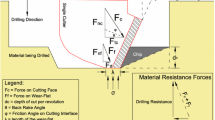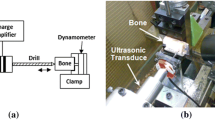Abstract
In order to prevent possible damages to soft tissues, reliable monitoring methods are required to provide valuable information on the condition of the bone being cut. This paper describes the design of an electrical impedance sensing drill developed to estimate the relative position between the drill and the bone being drilled. The two-electrode method is applied to continuously measure the electrical impedance during a drill feeding movement: two copper wire brushes are used to conduct electricity in the rotating drill and then the drill is one electrode; a needle is inserted into the soft tissues adjacent to the bone being drilled and acts as another electrode. Considering that the recorded electrical impedance is correlated with the insertion depth of the drill, we theoretically calculate the electrode-tissue contact impedance and prove that the rate of impedance change varies considerably when the drill bit crosses the boundary between two different bone tissues. Therefore, the rate of impedance change is used to determine whether the tip of the drill is located in one of cortical bone, cancellous bone, and cortical bone near a boundary with soft tissue. In vitro experiments in porcine thoracic spines were performed to demonstrate the feasibility of the impedance sensing drill. The experimental results indicate that the drill, used with the proposed data-processing method, can provide accurate and reliable breakthrough detection in the bone-drilling process.





Similar content being viewed by others
References
Agilent Technologies Co. Ltd. Agilent Impedance Measurement Handbook: a Guide to Measurement Technology and Techniques, 4th ed, Agilent Technologies, 2009.
Bolger, C., C. Carozzo, T. Roger, L. McEvoy, J. Nagaria, G. Vanacker, and M. Bourlion. A preliminary study of reliability of impedance measurement to detect iatrogenic initial pedicle perforation (in the porcine model). Eur. Spine J. 15:316–320, 2006.
Bolger, C., M. O. Kelleher, L. McEvoy, M. Brayda-Bruno, A. Kaelin, J.-Y. Lazennec, J.-C. Le Huec, C. Logroscino, P. Mata, P. Moreta, G. Saillant, and R. Zeller. Electrical conductivity measurement: a new technique to detect iatrogenic initial pedicle perforation. Eur. Spine J. 16:1919–1924, 2007.
Bonifasi-Lista, C., and E. Cherkaev. Electrical impedance spectroscopy as a potential tool for recovering bone porosity. Phys. Med. Boil. 54:3063–3082, 2009.
Faes, T. J. C., H. A. van der Meij, J. C. de Munck, and R. M. Heethaar. The electric resistivity of human tissues (100 Hz-10 MHz): a meta-analysis of review studies. Physiol. Meas. 20:R1–R10, 1999.
Gabriel, C., S. Gabriel, and E. Corthout. The dielectric properties of biological tissues: I. Literature survey. Phys. Med. Biol. 41:2231–2249, 1996.
Gabriel, S., R. W. Lau, and C. Gabriel. The dielectric properties of biological tissues: II. Measurements in the frequency range 10 Hz to 20 GHz. Phys. Med. Biol. 41:2251–2269, 1996.
Geddes, L. A., and L. E. Baker. The specific resistance of biological material—A compendium of data for the biomedical engineer and physiologist. Med. Biol. Eng. 5:271–293, 1967.
Grimnes, S., and Ø. G. Martinsen. Bioimpedance and Bioelectricity Basics, 2nd ed. London: Academic Press, pp. 161–177, 2008.
Guimerà, A., E. Calderón, P. Los, and A. M. Christie. Method and device for bio-impedance measurement with hard-tissue applications. Physiol. Meas. 29:S279–S290, 2008.
IEEE Standard C95.1, IEEE Standard for Safety Levels with Respect to Human Exposure to Radio Frequency Electromagnetic Fields, 3 kHz to 300 GHz, IEEE, 1999.
Ivorra, A. Contributions to the measurement of electrical impedance for living tissue ischemia injury monitoring, PhD Thesis, Universitat Politècnica de Catalunya, Departament D’Enginyeria Electrònica, 2005.
Ivorra, A., R. Gómez, N. Noguera, R. Villa, A. Sola, L. Palacios, G. Hotter, and J. Aguiló. Minimally invasive silicon probe for electrical impedance measurements in small animals. Biosens. Bioelectron. 19:391–399, 2003.
Kalvøy, H., C. Tronstad, B. Nordbotten, S. Grimnes, and Ø. G. Martinsen. Electrical impedance of stainless steel needle electrodes. Ann. Biomed. Eng. 38:2371–2382, 2010.
Laufer, S., A. Ivorra, V. E. Reuter, B. Rubinsky, and S. B. Solomon. Electrical impedance characterization of normal and cancerous human hepatic tissue. Physiol. Meas. 31:995–1009, 2010.
Lee, W. Y., C. L. Shih, and S. T. Lee. Force control and breakthrough detection of a bone-drilling System. IEEE/ASME Trans. Mechatron. 9:20–29, 2004.
Oehme, F. In: Sensors, A Comprehensive Survey, Chemical and Biochemical Sensors, Part I, Vol. 2, edited by W. Gopel, T. A. Jones, M. Kleitz, J. Lundstrom, and T. Seiyama. Weinheim: VCH Verlagsgesellschaft mbH, 1991, pp. 314–332.
Sadleir, R. J., and A. Argibay. Modeling skull electrical properties. Ann. Biomed. Eng. 35:1699–1712, 2007.
Saha, S., and P. A. Williams. Comparison of the electrical and dielectric behavior of wet human cortical and cancellous bone tissue from the distal tibia. J. Orthop. Res. 13:524–532, 1995.
Sierpowska, J., J. Töyräs, M. A. Hakulinen, S. Saarakkala, J. S. Jurvelin, and R. Lappalainen. Electrical and dielectric properties of bovine trabecular bone—relationships with mechanical properties and mineral density. Phys. Med. Boil. 48:775–786, 2003.
Tijero, M., G. Gabriel, J. Caro, A. Altuna, R. Hernández, R. Villa, J. Berganzo, F. J. Blanco, R. Salido, and L. J. Fernández. SU-8 microprobe with microelectrodes for monitoring electrical impedance in living tissues. Biosens. Bioelectron. 24:2410–2416, 2009.
Yoshida, T., W. C. Kim, K. Kawamoto, T. Hirashima, Y. Oka, and T. Kubo. Measurement of bone electrical impedance in fracture healing. J. Orthop. Sci. 14:320–329, 2009.
Yoshida, T., W. C. Kim, Y. Oka, N. Yamada, and T. Kubo. Assessment of distraction callus in rabbits by monitoring of the electrical impedance of bone. Acta Orthop. 81:628–633, 2010.
Acknowledgments
This study was financially supported by the National Science & Technology Pillar Program of China (Grant No. 2012BAI14B01).
Author information
Authors and Affiliations
Corresponding author
Additional information
Associate Editor Sean S. Kohles oversaw the review of this article.
Rights and permissions
About this article
Cite this article
Dai, Y., Xue, Y. & Zhang, J. Drilling Electrode for Real-Time Measurement of Electrical Impedance in Bone Tissues. Ann Biomed Eng 42, 579–588 (2014). https://doi.org/10.1007/s10439-013-0938-8
Received:
Accepted:
Published:
Issue Date:
DOI: https://doi.org/10.1007/s10439-013-0938-8




